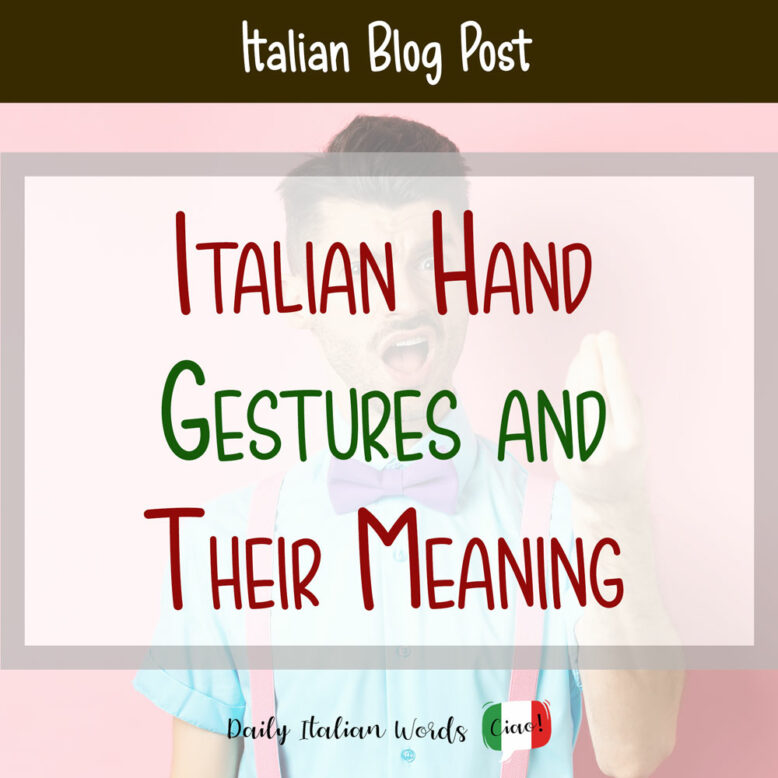As many people know, Italians gesticulate a lot and the gestures they make are never random, but have a very precise meaning. This habit seems to date back to when the Italian peninsula was divided into numerous states and different languages and dialects were spoken. Gestures became a sort of common language, a tool for communication between people who had different mother tongues.
In this article, we take a took at twenty of the most common Italian hand gestures people use in their daily interactions. Some are so ingrained that Italians find it impossible to speak without using them!

1) The “Pinched Fingers” Gesture
The most common Italian hand gesture is known as the “pinched finger” gesture, or as its known in Italian, il gesto del carciofo (lit. the artichoke gesture) or mano a borsa (lit. purse hand). To make this gesture, touch your fingers and thumb together, and shake your hand in front of your face. Used to express disbelief, frustration and disagreement, it can mean a number of things including:
- Ma che cosa vuoi? = What do you want?
- Ma cosa dici? = What are you saying?
- Ma cosa stai facendo? = What are you doing?
In short, it’s almost like a question mark placed at the end of a spoken sentence!
This gesture is so ubiquitous that it has even earned its own emoji, dubbed the Pinched Finger Emoji: 🤌 🤌🏾.
2) The “Getting Along” Gesture
By bringing together the index fingers of your two hands and tapping them together, you are implying that two people or two things that get along or go together very well.
3) The “Money” Gesture
When you rub your thumb, index and middle finger together, there’s no doubt that the topic of discussion is soldi (“money”)!
4) The “You’re Late” Gesture
If your friend taps their watch with their index finger repeatedly when you meet them for lunch, it’s probably safe to assume that you haven’t made it to the restaurant on time!
5) The “Horns” Gesture
When an Italian raises their index and pinkie finger, while making a fist, they are trying to ward off danger or protect themselves from evil. Some people may also say the word “tiè” (Take that!) while performing the gesture. Because the gesture looks a bit like a horned beast, it is often referred to as fare le corna (“to make the horns”).
6) The “Yummy” Gesture
If you see someone pressing their index finger into their cheek and turning it, you can be sure that they are thoroughly enjoying their meal!
7) The “Go Away” Gesture
When you place your hand perpendicular to the floor and shake it up and down, it means “go away” or “get lost”.
8) The “Kissing” Gesture
If you kiss your hand with your fingers bunched together, you are saying that something is wonderful.
9) The “Get to the Point” Gesture
If you open and close your fingers with your palms turned upwards, you are asking the other person to summarise, or get to the point.
10) The “Question” Gesture
Raising your index finger means that you want to ask a question. This is a gesture we also use in English speaking countries.
11) The “I don’t like it” Gesture
By tapping your hand to your chest, with your fingers facing down, you are saying that you really don’t like someone or something.
12) The “Perfect” Gesture
If you create a ring with your thumb and forefinger and draw an imaginary line in front of your face, you’ve made the Italian gesture for “it’s perfect”!
13) The “Be Quiet” Gesture
If you want someone to “be quiet” you can put your index finger on your mouth and say “shhh”. This gesture should be easy to remember as English speakers also use it!
14) The “I forgot” Gesture
When you hit your forehead with your hand, it means that you forgot (about) something or forgot to do something.
15) The “Phew” Gesture
This gesture, which involves wiping imaginary sweat from your forehand with your hand, is akin to the word “phew” in English. You can use when you feel extreme relief after having averted a dangerous situation.
16) The “Clever” Gesture
If you want to say that someone is “clever” or “sneaky” using an Italian gesture, you can draw a line on your cheek with your thumb. It’s as simple as that!
17) The “Calm Down” Gesture
Are you talking to someone who is overreacting? Then you can push your hands down in front of the chest to say “calm down”.
18) The “Scary” Gesture
If you open and close your fingers while placing them in a vertical position, you are insinuating that the other person is scared of something, and simultaneously deriding them for their fear. This isn’t the nicest of gestures so use it sparingly!
19) The “Let’s Go” Gesture
When you move your whole hand backwards or sideways in close proximity to your chest, it means “come on, let’s go”. Italians tend to use it when they are feeling impatient and want to get a move on.
20) The “It Went Well” Gesture
Sticking one or both of your thumbs up in the air is the same as saying “it went well”. And yes, we use this in English speaking countries too!
Which of these Italian hand gestures are new to you? Let us know in the comment section below!

Allegra Lucarelli, known professionally as allegraLu, is a certified Neurolanguage Coach for child bilingualism and a native Italian speaker who speaks English fluently. She helps families raise their children to be bilingual and multilingual at AllegraLu.com.


